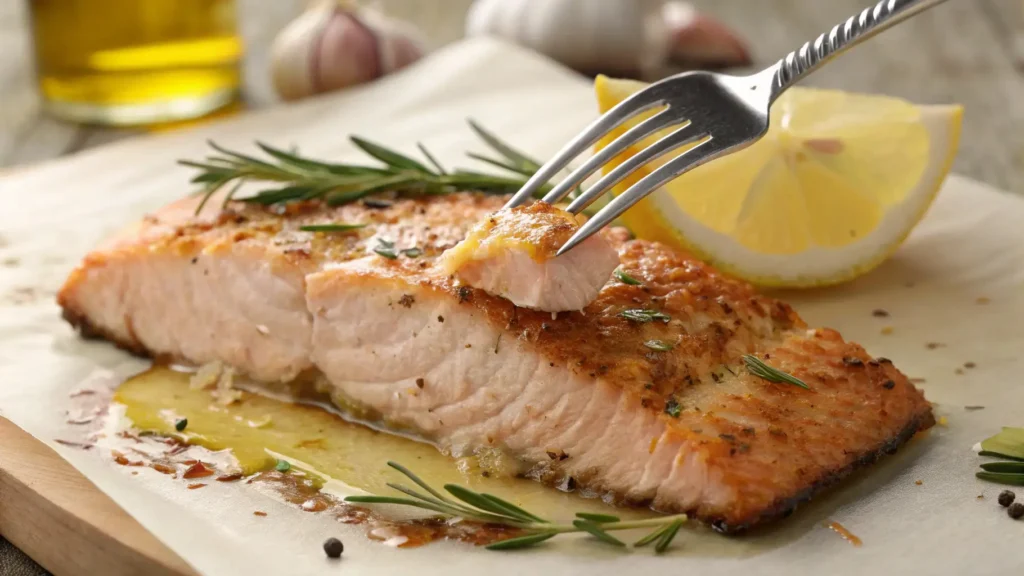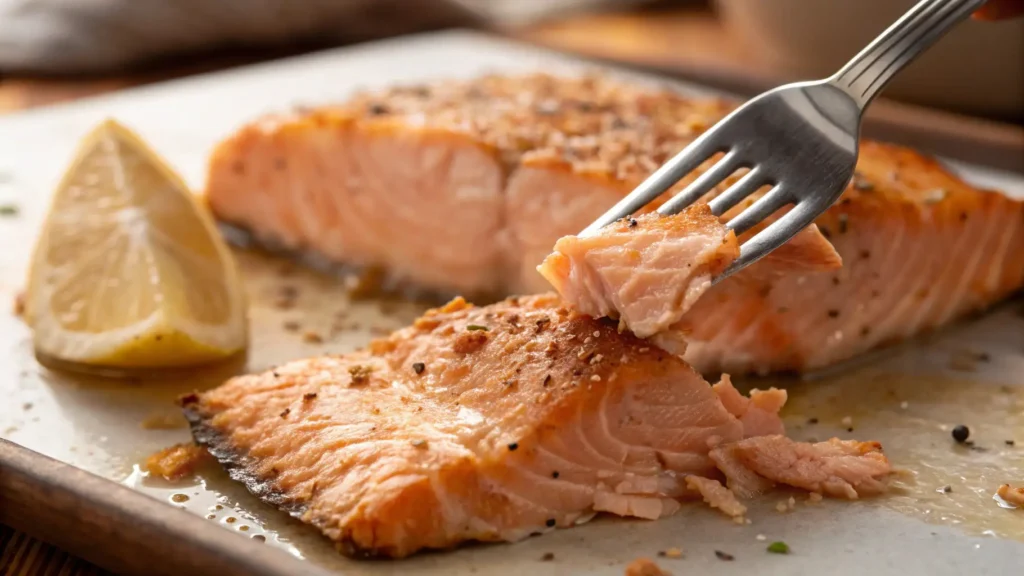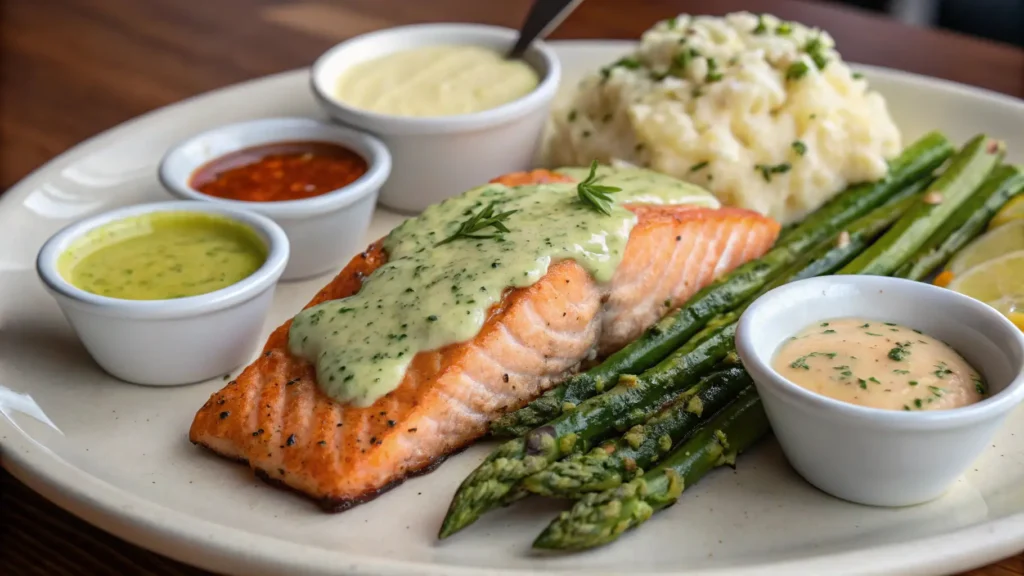Salmon is a versatile, nutrient-rich fish that has earned its place as a favorite in kitchens worldwide. While its buttery flavor and tender texture make it a delight to cook, achieving perfection can sometimes feel elusive. Many home cooks wonder, “What is the secret to the best salmon?”

The truth lies in the details—selecting high-quality, mastering the right techniques, and pairing it with flavors that complement its natural richness. In this article, we’ll explore the secrets to cooking salmon that’s moist, flavorful, and restaurant-quality every time.
Vous avez dit :
continue
ChatGPT a dit :
Choosing the Best Fish
The foundation of a great dish starts with selecting the right fillet. With so many options available, understanding the differences will help you choose the best one for your recipe.
1. Wild-Caught vs. Farmed
- Wild-Caught: Varieties like Sockeye or Coho have a firmer texture and a more robust, pronounced taste. These fish are often leaner, making them ideal for those who prefer a less fatty option.
- Farmed: Options such as Atlantic varieties are richer and more buttery due to their higher fat content. They’re perfect for recipes that call for a tender, melt-in-your-mouth texture.
💡 Pro Tip: For sustainability, look for certification from the Marine Stewardship Council (MSC) or similar organizations.
2. Freshness Matters
Fresh fillets deliver the best flavor and texture. When buying, check for:
✅ Bright, shiny skin and vibrant flesh.
✅ A clean, mild smell (avoid any strong fishy odors).
✅ Firm texture that bounces back when gently pressed.
💡 Pro Tip: If fresh options aren’t available, choose high-quality frozen fillets that have been flash-frozen to preserve flavor and texture.
3. Types and Their Characteristics
Different varieties have unique flavors and textures:
- King (Chinook): The richest and most flavorful, known for its high-fat content.
- Sockeye: Deep red in color with a bold, pronounced taste.
- Coho: Milder and versatile, great for a variety of recipes.
- Pink: Light in flavor, making it a great choice for salads or casseroles.
Choosing the right type ensures your dish has the perfect balance of texture and flavor. Whether you prefer something bold and firm or buttery and delicate, understanding these differences helps you make the best selection!
For more guidance on choosing salmon, visit Feedish Recipes.
Seasoning can make or break your salmon. The goal is to enhance its natural flavor without overpowering it. Using the right blend of herbs, spices, and marinades ensures a well-balanced dish with depth and complexity. Here’s how to season salmon perfectly:
1. Essential Seasonings
Some of the best seasonings are simple yet effective. These classic ingredients bring out the best in salmon’s rich, buttery flavor:
- Salt and Pepper: A light sprinkle of sea salt and freshly cracked black pepper is often all you need to elevate the taste.
- Lemon and Herbs: Fresh herbs like dill, parsley, thyme, and rosemary pair beautifully with salmon, adding a fragrant, earthy touch that complements its richness.
- Garlic and Onion Powder: These add subtle savory depth without overpowering the fish.
💡 Pro Tip: For a bright and citrusy kick, add a bit of lemon zest before cooking.
2. Marinades for Extra Flavor
Marinating salmon enhances its flavor and helps keep it moist. Depending on your desired taste profile, here are some great marinades to try:
- Soy Sauce and Ginger: Adds an Asian-inspired umami depth with a hint of warmth.
- Honey and Mustard: Creates a sweet-savory glaze that caramelizes beautifully when cooked.
- Lemon and Olive Oil: A bright, zesty marinade that keeps salmon fresh and flavorful.
Tip: Marinate the fish for no more than 30 minutes to avoid breaking down its delicate texture. Over-marinating can make salmon mushy rather than firm and flaky.
3. Dry Rubs for a Flavorful Crust
For a bold, well-seasoned crust, coat salmon in a dry rub before cooking. Dry rubs add texture and lock in flavor without additional moisture:
- Smoky-Sweet: A mix of paprika, garlic powder, and brown sugar enhances salmon’s natural sweetness while adding a hint of smokiness.
- Spicy Kick: A combination of chili powder and cumin creates a bold, slightly smoky heat perfect for blackened salmon.
- Mediterranean Blend: Mix oregano, garlic powder, lemon zest, and black pepper for a fresh, herbaceous profile.
💡 Pro Tip: Let the dry rub sit on the salmon for 10–15 minutes before cooking to allow the flavors to penetrate.
Mastering Cooking Techniques
The way you cook salmon can make all the difference between a perfectly tender filet and a dry, overcooked dish. Here’s a guide to mastering the most popular methods:

1. Grilling
Grilling salmon imparts a smoky flavor and crisp exterior, making it a favorite for summer cookouts.
- Preparation: Brush it with oil or a marinade to prevent sticking.
- Grill Temperature: Medium-high heat (around 375°F/190°C).
- Cooking Tip: Place it skin-side down on the grill. Cook for 6–8 minutes per side, depending on the thickness.
Pro Tip: Use a cedar plank for grilling to enhance flavor and prevent the fish from sticking to the grates.
2. Baking
Baking is one of the easiest and most foolproof methods for cooking salmon.
- Preparation: Preheat the oven to 375°F (190°C). Place the salmon on a lined baking sheet.
- Seasoning: Brush with olive oil or melted butter, and sprinkle with salt, pepper, and herbs.
- Cooking Time: Bake for 12–15 minutes or until the internal temperature reaches 145°F (63°C).
Pro Tip: Add sliced lemons or a drizzle of white wine to the baking dish for extra moisture.
3. Pan-Searing
Pan-searing is perfect for achieving a crispy skin and a golden-brown crust.
- Preparation: Heat a mix of butter and oil in a non-stick skillet over medium-high heat.
- Cooking Tip: Place it skin-side down and press gently to ensure even contact with the pan. Cook for 4–5 minutes on the skin side, then flip and cook for another 2–3 minutes.
Pro Tip: Don’t overcrowd the pan to ensure even cooking.
4. Broiling
Broiling caramelizes the surface of the salmon, creating a slightly crispy, flavorful crust.
- Preparation: Preheat the broiler and place it on a baking sheet lined with foil.
- Seasoning: Use a glaze, such as honey mustard or teriyaki, to enhance the browning.
- Cooking Tip: Broil for 6–8 minutes, keeping a close eye to avoid burning.
For more detailed cooking tips, explore Feedish Recipes.
Achieving the Perfect Salmon Texture
The hallmark of great salmon is its moist, flaky texture. Follow these tips to avoid overcooking and ensure a tender result:

1. Check Doneness
- Use a meat thermometer to check the internal temperature. The FDA recommends cooking it to 145°F (63°C), but many chefs prefer 135°F (57°C) for a softer, juicier texture.
- Alternatively, use a fork to gently flake it. It should separate easily without being dry.
2. Prevent Dryness
- Avoid Overcooking: Remove salmon from heat just before it’s done, as it will continue to cook from residual heat.
- Keep It Moist: Baste the salmon with butter, olive oil, or marinade during cooking to lock in moisture.
3. Use the Right Cooking Tools
- A cast-iron skillet ensures even heat distribution for pan-searing.
- Parchment paper helps retain moisture when baking.
Complementary Sauces and Sides

The best salmon dishes often include a well-paired sauce and thoughtfully chosen sides to complete the meal. Here are some ideas to elevate your salmon to restaurant-quality status:
1. Sauces for Salmon
- Lemon Butter Sauce: A classic pairing, this sauce adds brightness and richness.
- Dill Cream Sauce: A creamy and herbaceous complement for baked or poached salmon.
- Honey Mustard Glaze: A sweet and tangy option that works well with grilled or broiled salmon.
- Teriyaki Sauce: Perfect for an Asian-inspired dish, providing a savory and slightly sweet flavor.
Pro Tip: Drizzle the sauce lightly over the salmon just before serving, or serve it on the side for dipping.
2. Side Dishes to Pair with Salmon
- Grains: Quinoa, wild rice, or couscous provide a hearty base that absorbs flavors from the salmon and sauce.
- Vegetables: Roasted asparagus, Brussels sprouts, or a fresh green salad add color and nutrition.
- Potatoes: Mashed, roasted, or scalloped potatoes offer a comforting complement to salmon’s richness.
- Bread: A crusty baguette or garlic bread is perfect for soaking up sauces.
For more pairing inspiration, check out Feedish Recipes.
FAQs About Cooking the Best Fish
1. How do I know if my fish is fresh?
Fresh fillets should have vibrant flesh, a clean smell, and a firm texture. Avoid any that appear dull or have an overly strong fishy odor.
2. Should I leave the skin on when cooking?
Yes, keeping the skin on helps protect the fillet during cooking and adds a crispy texture when pan-seared or grilled. If preferred, you can remove it after cooking.
3. What’s the healthiest way to prepare it?
Baking, steaming, or poaching are the best methods for preserving nutrients while using minimal added fats. These techniques allow for a lighter, more natural taste.
4. Can I marinate overnight?
It’s best to limit marination to 30 minutes to an hour. Acidic ingredients like lemon or vinegar can break down the texture if left for too long.
5. How do I prevent sticking when cooking?
Brushing with oil and ensuring the pan or grill is properly preheated can help prevent sticking. Using a non-stick pan or grilling on foil also minimizes this issue.
6. What’s the best way to reheat?
For the best results, reheat in a low oven (275°F/135°C) for 10–15 minutes, covering with foil to retain moisture and prevent drying.
Conclusion
The secret to perfectly cooked fish lies in careful preparation, from selecting high-quality fillets to mastering the right cooking techniques. Whether you prefer grilling, baking, or pan-searing, maintaining natural moisture and pairing it with complementary flavors ensures a delicious result.
By following the tips in this article, you can consistently create flavorful, well-balanced dishes. Experimenting with different seasonings, cooking methods, and accompaniments will help make each meal unique and impressive.
For more expert salmon recipes and tips, visit Salmon Bites Recipe.
